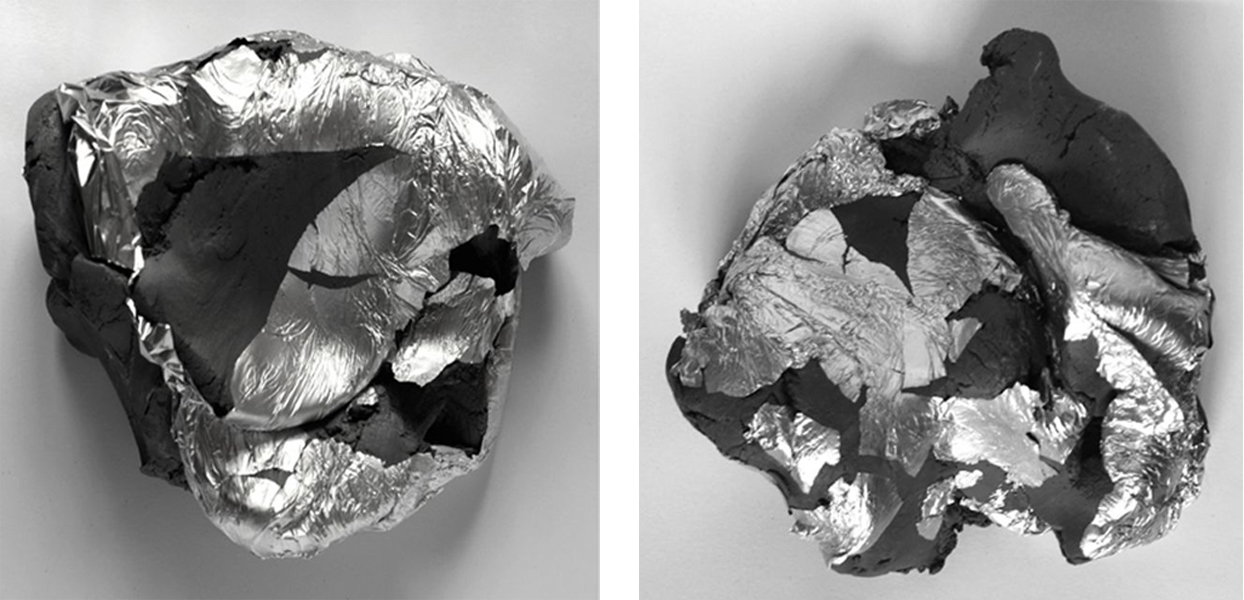Nicole De Brabandere
| Surface Tension | ||
Surface
tension is an important mode of emphasis for activating transversal operations, since it is a particularly accessible way to begin to think with the relation between surface and the felt limits of the body. The proposition to think the corporeal often begins with thinking with the bounds of corporeal extremities—the blunted tips of the fingers or the limit of the skin against the surface of sitting. When one considers these extremities in instances of contact, form and position become felt as tensions, frictions, tensilities and pressures. This generates the felt thought of a corporeal that is co-composed multiply and transversally in the lived ecology.
I propose the process of folding clay as technique for amplifying this process and for inscribing a corporeal that exceeds the containment of figurative form. Like the continuous contour, kneading clay sets in motion a continuous gesture of turning the clay over itself, a gesture that holds a rhythm while recomposing the surface with the interior consistency of clay. In the rhythm and continuous resurfacing, folding becomes a limit where the difference between consistencies, bodies and movements exhausts. The edges and boundaries of things find new interiorities and alliances that exceed contained forms. In the orbit of kneading, the recomposing surface of clay intensifies the skin as a potential of co-composition.
Knead a sheet of textile or plastic into clay and instead of the clay folding endlessly, into an infinity of pleats, the fabric makes the weight of the clay felt as a pressure that is distributed over the surface, edging it into taut stretch. The intense tension of the membrane surface intensifies the kneading clay by separating and holding it from folding back into itself, activating a form-giving force amidst and in contrast to the continuous circling movement of the kneading surface.
The dynamics with which the surface composes and recomposes emergent tensions between and across different material surfaces and the time of video capture is further developed in the paper 'Experimentation in the “Science of the Possible” Specifying the Generative Dynamism between Form and Exhaustion through Divergent Series' available here: | ||
 Marble Knead (2015) | ||
 Cellophane Knead (2015) | ||
| Then the surface emerges between ground and elastic stretch,
| ||
 Knuckle
Knead (2015)
| ||
| And the grip closes in and folds into knuckles, bulging knuckles that bend,
plastic in the mass of clay, smooth, plastic fingers
creasing the surface from the inside, out.
| ||
 Marble Knead (2015) | ||
|
And elastic is viscous as it stretches layers of red, blue and yellow pigment into flows
before it releases liquid fingers
| ||
 Foil Knead (2015) | ||
| Then the clay churns a consistency that splits brittle foil edges curling beams of light out from its undersides, undersides where weighted tack normally never lets the light through sticks the damp surface
| ||
 Thread Knead (2015) | ||
|
The weave returns, imprinted, between weft and the stretching surface of plastic clay. At the threshold of surface separating, the
threads
fast and tight by the absorbent compression of paper.
|